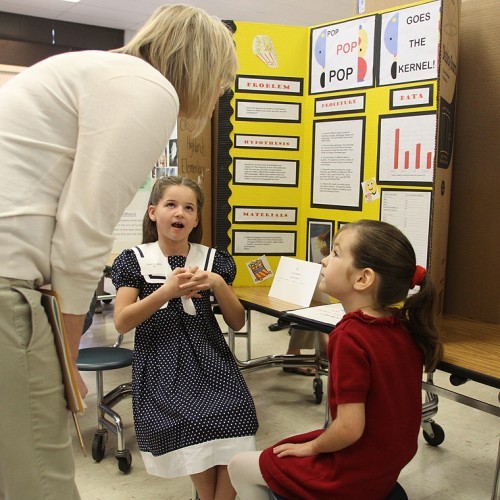
INDIAN RIVER COUNTY — Hundreds of students descended on Gifford Middle School Saturday morning, prepared to face the judges and explain their Science and Engineering Fair projects. More than 300 entries were submitted, evaluated by 133 judges.
“I was really impressed,” said 5-year judge Nick Polge, taking a brief break between evaluating the middle and high school projects. He couldn’t choose from among his favorites, noting they were all “extremely good.”
“The students are all very enthusiastic about their projects,” Polge said.
Among those entered was a sixth grade project by Brian Rhodes and Sarah Nichols, of Sebastian River Middle.
The pair studied the safety of local clams, testing them for mercury levels.
Nichols explained that mercury winds up in the Indian River Lagoon due to stormwater runoff – water that flows into the lagoon from roads, roofs and other developments. That mercury then gets filtered through the clams.
Rhodes noted that the amount of mercury found in clams could impact their value at market and that an acceptable amount of mercury is just 0.1 part per million.
Clams taken from near Orchid and from north Sebastian are safe, Rhodes and Nichols’ study determined – at 0.085ppm and 0.075ppm, respectively.
“They’re OK to eat,” Nichols said.
Clams taken from Cedar Key, however, are not – with 0.15ppm.
They determined the difference in mercury levels is due to the high density of development in the Cedar Key area.
Gifford Middle School seventh grader Gracie Rubinski tested 40 plants to determine which would get better results – growing in soil or growing through hydroponics.
She spent two weeks and more than 25 hours counting the leaves and blooms and measuring the plants.
Throughout the process, she attracted three unexpected visitors, she said – snails and caterpillars that munched on her tomato plants’ leaves and frogs that would “jump on people as they walked by!”
At the end of her experiment, Rubinski’s hypothesis was proven half-right. She had suspected that hydroponic growing with fertilized water would perform the best overall. While the fertilized water process did yield the best results of the hydroponic samples, the fertilized soil actually did the best.
Rubinski said the take-away from her experiment is that hydroponic is not always the best way to grow a tomato plant.
Nahuel Varela, a fifth grader at Master’s Academy, studied plants, as well, testing the effect changing the amount of light Sweet Basil plants receive would have on growth.
He determined that giving the plants six hours of light – either sun or fluorescent – and then six hours of dark, twice a day, yielded faster growth than leaving the light alone.
Varela said his findings could help farmers grow their plants twice as fast and get their products to market faster.
And Steven Russell, a fourth grader at Sebastian Elementary, discovered with his experiment “Snowball to Know All” that taking “brain breaks” between studying and testing can improve test scores.
He said his class, lead by Mrs. Murto, routinely takes brain breaks by balling up pieces of paper (the snowballs) and tossing them around the room while music plays. When the music stops, the testing can begin.
He studied his classmates and discovered that while at rest, girls tend to keep thinking about the matter at hand while boys “zone out” – blanking their minds.
The “snowball” activity keeps the brain engaged and helped improve their scores.
The elementary school Science and Engineering Fair participants will receive awards for their work Sunday during a special ceremony at the Sebastian River High Performing Arts Center at 3 p.m.
Those in middle and high school will have to wait until Jan. 26 to find out how they placed. That ceremony will be held at 6 p.m. at the Vero Beach High School Performing Arts Center.



